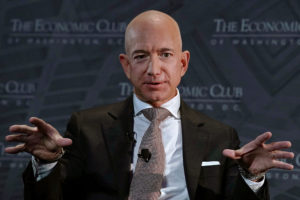This midterm year, in which many states have to choose between non-entities and the certifiably insane, Ohio is blessed by a real political dogfight. The Senate battle between representative Tim Ryan and Hillbilly Elegy author, JD Vance, is becoming one for the ages.
At issue is the very nature of populism. The 38-year-old Vance, a Republican who emerged from Appalachian poverty to serve in the Marines and attend Yale Law School, epitomises the grassroots radicalism of the Scots-Irish in America: anti-elitist, culturally conservative, sceptical toward draconian climate policies and hostile toward China. Ryan, after 20 years as the Democratic representative from the former industrial stronghold of Northeast Ohio, touts a more traditional, pro-union, but also firmly anti-globalist politics.
The state’s size, and its location in the politically volatile Midwest, render it a critical battleground. Ohio is home to 11 million people, making it the seventh largest state in the union. It has all the basic components of 21st-century America: challenged, largely minority cities such as Cleveland and Toledo, relatively prosperous Cincinnati, an emerging boom town in Columbus (the university town that also serves as state capital), and a vast array of rural towns and villages.
Ohio may no longer be the decisive “bellwether” of America — it has been trending Republican for over a decade — but it is still a competitive state. Veteran political scientist Herb Asher notes that despite its GOP leanings, Ohio remains open for Democratic challengers in a way that is hard to imagine in deep-red states such as Texas. In Ohio, successful Democrats are not gentry types like California Governor Gavin Newsom, but hard-bitten, pro-working class New Dealers like Senator Sherrod Brown. Ryan is cut from much the same cloth. At a time of heated polarisation, he has cast himself as a folksy, open-minded family man who puts country over party.
To his credit, Ryan has been willing, at least on the campaign trail, to declare his independence from Democratic orthodoxy. He has supported fracking and opposed Joe Biden’s student-loan forgiveness scheme. He has praised Trump’s protectionism and opposition to China. He does not much appeal to the tech-and-finance elites who now dominate the Democratic Party — one reason, suggests Midwest scholar John Russo, that he has been slow to attract big donor money.
Vance, by contrast, is not a great candidate. On stage, the hillbilly turned intellectual and venture capitalist is rigid and off-putting — you would rather sink a couple of bourbons with Ryan. Even Vance’s populism seems less people-friendly than Ryan’s. Vance’s biggest blessing, and greatest curse, is Donald Trump, who carried Ohio twice, and whose endorsement saved Vance in a hard-fought Republican primary. Like many conservative intellectuals, Vance opposed Trump at first but then quickly cosied up to him after he won. Ryan has not hesitated to make hay of this about-face, saying that Ohio needs “an ass-kicker not an ass-kisser”.
The outcome of the race will depend on two swing demographics: working-class whites and suburbanites. According to Russo, the fall-out from the Supreme Court’s abortion decision, combined with the increasingly rancid stench of Trumpism, could alienate affluent suburban voters, particularly in burgeoning cities such as Columbus. “The middle-class suburban moderate voter is the key for Ryan,” Russo notes.
If the American economy were not experiencing massive inflation under a Democratic president, Ryan would most probably win. But, like other Democrats, he is haunted by the state of the economy under Joe Biden. Crime, on the rise in Ohio cities, is another vulnerability. Vance has also tried to score points by associating Ryan with Biden’s border policies, which the Congressman has criticised but not opposed. But perhaps the most effective Republican talking point is that Ryan has raised campaign funds from some of the biggest distributors of opioids — this in a state that has been devastated by the opioid epidemic. Yet here, too, Vance has his own skeletons in the form of a failed non-profit he set up to combat addiction.
Ultimately the decisive issue may turn out to be energy. Much of Ohio’s recent resurgence has relied on massive growth in the state’s natural gas sector, which has boomed as the vast Appalachian basin has increased production fivefold since 2010. This has proved not just a spur for direct employment, but has also attracted investment into the state. In 2020, Ohio gained more than four times the total investment than California. Perhaps the biggest boon has been Intel’s proposal to invest $20 billion in a new chip plant in the Columbus suburbs. And just this week, Honda and LG Energy Solutions announced a $4 billion car battery plant in another adjacent county.
Much of the credit for this growth must go to Republican Governor Mike DeWine, whom Democrat Asher describes as “a non-Trumpster”. He is on his way to a landslide re-election; this form of Republicanism — conservative but not crazy — has also characterised current Senator Rob Portman, a pragmatic Republican who in 2016 won 300,000 voters more than Trump could muster in the state. But DeWine also does not have Donald Trump on his back, and is not running against anyone as effective as Ryan.
Ryan’s key problem lies with the increasingly progressive, climate-obsessed Democratic Party. Even as he describes fracking as a “great opportunity” to blue-collar audiences, Ryan also supported Biden’s drilling moratorium and opposed legislation to deregulate the permitting process for oil and gas pipelines. He even embraced the anti-fossil fuel jihad of the Green New Deal.
If he loses, Ryan can thank the influence of these coastal, establishment initiatives. “Tim must deal with national Democrats who are a drag on his campaign,” Asher notes. “They are seen as anti-exploration and anti-pipeline. These positions are less popular here than in California.” Ryan’s riposte, labelling Vance a “San Francisco phoney” seems a bit desperate when hurled at someone who, after all, grew up in one of Ohio’s most hardscrabble communities, served in the Marines, and then chose to return to his home state. Ryan has to hope there’s not an early onset of the cold winter that will see much higher heating prices, further highlighting the energy issue.
Many working-class Democrats, notes long-time consultant Ruy Texeira, rightfully see the current green policies essentially as an abandonment of their interests and communities. But just as Vance can’t ditch Trump (who has been losing support in the state), Ryan is stuck with Pelosi, Schumer and Senator Bernie Sanders. Ryan’s earthy Left-populism may be appealing, but Biden’s standing in the state is about the same as in deep-red Texas. The winner in Ohio will be the candidate who can overcome the burden of their political affiliation — an indictment ultimately of both national parties, and their contemporary detachment from flyover America.
Disclaimer
Some of the posts we share are controversial and we do not necessarily agree with them in the whole extend. Sometimes we agree with the content or part of it but we do not agree with the narration or language. Nevertheless we find them somehow interesting, valuable and/or informative or we share them, because we strongly believe in freedom of speech, free press and journalism. We strongly encourage you to have a critical approach to all the content, do your own research and analysis to build your own opinion.
We would be glad to have your feedback.
Source: UnHerd Read the original article here: https://unherd.com/




